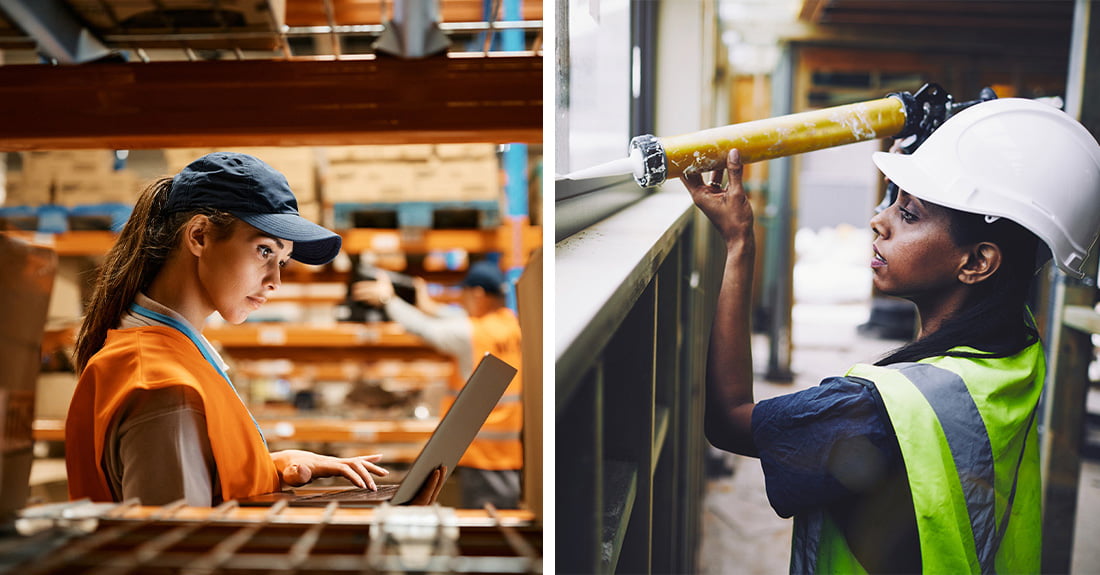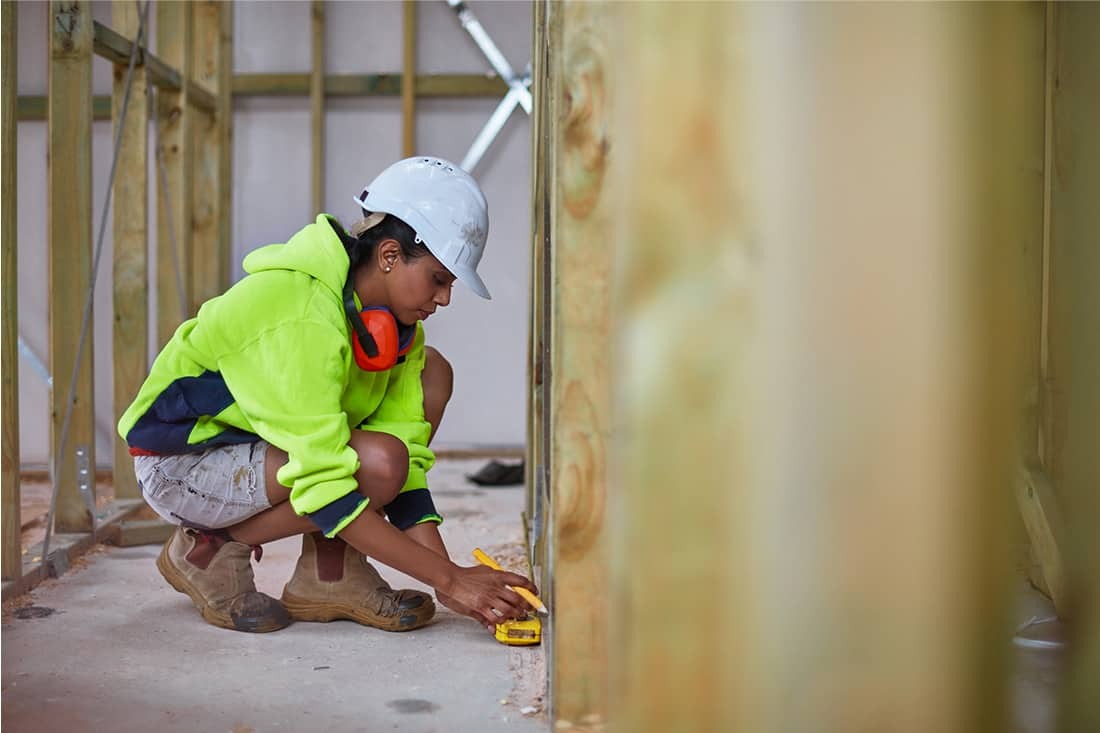More women are making the decision to become skilled tradeswomen as a career choice. With good pay, a desk-free job, and wide range of opportunities in a variety of industries, the stigma of women not belonging in the trades is disappearing. In its place is a future built upon a more diverse and dynamic industrial workforce.
A report published in 2022 by the U.S. Department of Labor reveals that the number of apprenticeships held by women has more than doubled from 2014 to 2022 and now make up nearly 14% of active apprenticeships. In 2021, “the number of women working in trades occupations reached the highest level ever, at just over 314,000. During the last five years, the number of tradeswomen increased by almost one-third.”
The picture being painted here is a positive one. Women are pursuing careers in what were traditionally considered to be “down and dirty” jobs in male-dominated fields. With the economy continuing to grow, skilled labor is badly needed in almost every trade, and more women are seizing the opportunity to learn a high-demand trade. A recent report published by Classet.org, an employment hub for individuals and employers, states that “we have talked to many unions and companies and they all are begging for more women in their trades!”
TRADES THAT ARE ACTIVELY RECRUITING FOR WOMEN

So, which trades in particular are seeking out women to fill the employee roster? Well, most of them actually, but as Classet points out, the top fields hiring women include:
- HVAC (Heating, Ventilation, Air Conditioning)
A growing field requiring strong problem-solving skills.
- Electrical Engineering
There is a serious shortage of electricians in this industry, and the job can be done successfully by women right up until retirement age.
- Plumbing
Currently in high demand due to an aging population, the need for plumbers is expected to grow by 26% over the next decade. And the benefits are a real draw.
- Welding
Once made famous by the movie “Flashdance,” welding is a terrific career choice. Studies show that women have steadier hands and have greater balance; ideal for this kind of work.
- Carpentry
By far one of the most versatile trades, this is a great fit for women who are skilled at working with their hands and enjoy the flexibility of part-time work and working from home.
- Construction Manager
Construction work for women brings great news. This field has the smallest pay gap between men and women, with the median salary being around $100K, with the top 25% are earning over $128K.
Other areas where women are being sought include painting and decorating, 3D printing, wind and solar, automotive (especially sales), aircraft maintenance, bricklaying, refuse collection, crane operation, tractor-trailer driving, and women in the warehouse. The message here is loud and clear – trades need these positions filled, and they’re looking specifically for more women to come in and break a few industrial-grade glass ceilings. Today, almost 9 in 10 tradespeople believe making the trades more welcoming to women would have a positive impact on the industry. And with trade school costs averaging around $35k, as opposed to a 4-year college degree that costs $100k, it is no wonder more women are joining these industries.

Between February 2020 and March 2022, there was a 6% increase in construction jobs, and a 15% increase in transportation and warehousing jobs.
SOME CONTINUING CHALLENGES
As is to be expected, despite the many advances that have been made for women within the trades, there’s still a lot of work to be done. Trade jobs have been designed for and primarily occupied by men for hundreds of years, and that kind of status quo doesn’t disappear overnight.
- Currently, only 4% of all tradesmen are women, while 96% are men.
- Fewer that 2% of Pipelayers, plumbers, pipefitters, and steamfitters are women.
- When it comes to women in construction specifically, the numbers tell a bleak story: Women make up 2.5% of tradespeople; but they fill 87% of office roles, and 14% of staff executive positions.
- In the US, the Equal Employment Opportunity Commission receives more reports of sexual harassment from women working in male-dominated industries like construction, utilities, mining, and transportation and warehousing.
While women joining the trades has been showing positive signs, and has been trending in the right direction, many obstacles and challenges remain.
- Sexist stereotypes
Many people in the trades believe that women are the ‘weaker sex’ and less fit for jobs that require more physical labor.
- Pay disparity
Although pay disparity exists across all sectors, looking at welders for example, one of the highest earning trades, women make 84 per cent of what men earn in their first year of work.
- Sexual harassment
Places like building construction sites in particular can be hazardous for women, with sexual harassment often being ignored or swept under the rug.
- Pregnancy discrimination
Despite proactive efforts by the military, many trades will look unfavorably upon a woman who takes (or could take) time off to have a child as well as the additional workload that will be burdened by the organization during her absence – which could become permanent.
- Inappropriate and ill-fitting PPE (personal protective equipment)
Not surprisingly, personal protective equipment has traditionally been designed with men in mind and that’s starting to evolve. The tide is changing, as observed by Alyssa Sangirardi, Product Manager at Global Industrial, "over the last few years, we’ve seen a transformation in PPE manufacturing to meet the changing needs of women in the trades. Improvements such as vests with contoured waists, harnesses with adjustable waists, and glasses with smaller frame sizes all speak to the awareness that PPE needs to continue to evolve to keep women comfortable, productive, and most importantly safe while on the job." However, these changes take time to implement, and it could be a while before PPE for women and maternity is in plentiful supply across every industry.
- Physical limitations/discrimination (especially in construction)
The perception that women may not be able to handle physical labor on par with their male counterparts is slowly changing but will take time.
- Under-representation
The fact that 96% of your colleagues are men is a pause for concern for many women, most often because of the sexual harassment, stereotyping, and other discrimination that comes from outdated attitudes and views that have no place in modern society.
- Sexual discrimination
This is rife in “traditional” jobs for men, which includes welding, plumbing, construction, and automotive. The short story – men have always done these jobs; therefore, women cannot and/or should not do them. It’s a fallacy and continues to plague many trades.
- Imposter syndrome
There’s a lack of confidence among women that although they are more than qualified to do a trade job, they feel like a fraud or phony. Which dovetails into the final point:
- Lack of support from colleagues and management
If the support isn’t there from colleagues and managers, things can go from bad to worse very quickly. Educating the work force to be aware of unintentional biases may take time, but is something we all should work towards.
However, in every field these issues are being seriously targeted, and the path for women to have a career in the trades is being laid firmly. There are several great organizations supporting this charge, including:
- HVACR - Women in HVACR: is the first international organization for Women in the Heating, Ventilation, Air Conditioning & Refrigeration industry.
- HVACR Canada - Women In HVAC-R: On mission to provide a forum to promote the inclusion and advancement of women in the Heating, Ventilation, Air Conditioning and Refrigeration (HVAC-R) industry in Canada.
- Women in Plumbing & Piping: A membership organization focusing on the inclusion, empowerment, and support of women in the plumbing industry, from the field to the boardroom, providing a place for you to thrive and unlock your full potential.
- Tools & Tiaras: Passionate about creating an avenue where young girls can showcase their talents and succeed in the construction industry.
A multitude of grants are also available exclusively for women who want to pursue a career in the trades, so check local and national resources for more information, and seasoned training providers.
Overall, more women are needed in trades, and as more join the workforce, the size and quality of the future hiring pool of candidates will grow significantly. It has been over 80 years since Rosie the Riveter helped inspire women to enlist in the workforce, redefining the image of the feminine ideal. Today, “women have discovered that the trades not only offer stable, well-paying jobs with great benefits but also offer almost limitless opportunities for advancement.”And that’s something we can all celebrate, both now and with every generation that follows.
The information contained in this article is for informational, educational, and promotional purposes only and is based on information available as of the initial date of publication. It is the reader’s responsibility to ensure compliance with all applicable laws, rules, codes and regulations. If there is any question or doubt in regard to any element contained in this article, please consult a licensed professional. Under no circumstances will Global Industrial® be liable for any loss or damage caused by your reliance on this article.